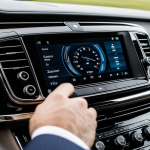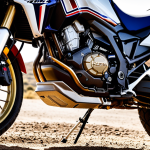Benefits of Upgrading the Honda VFR800 Exhaust System
Investing in an exhaust upgrade for the Honda VFR800 can yield significant advantages, notably in enhancing overall engine performance and increasing horsepower. Riders often experience a noticeable boost in throttle response, allowing for more efficient power delivery. This change translates to a smoother ride, especially at higher speeds or during acceleration.
The sound profile of the motorcycle undergoes a transformation with an acoustic improvement from upgraded exhaust systems. This enhancement provides a richer, more engaging auditory experience for both the rider and onlookers. The roars and rumbles characteristic of a finely tuned VFR800 engine are amplified, aligning the auditory aesthetic with the bike’s performance pedigree.
Also to see : Unlock the Secrets to Smooth Shifting: Essential UK Insights on Mastering Dual-Clutch Transmissions
Moreover, an upgraded exhaust can lead to increased fuel efficiency, as the freer flow of exhaust gases optimises combustion efficiency. This advantage not only prolongs the engine’s lifespan but also translates into cost savings on fuel over time. The combination of improved horsepower, sound, and efficiency makes exhaust upgrades a compelling decision for VFR800 enthusiasts aiming to enhance both the ride’s enjoyment and the vehicle’s value. Each of these benefits contributes to a higher-quality, more exhilarating motorcycle experience.
Overview of Exhaust Options for the Honda VFR800
Selecting the right exhaust options is crucial for enhancing your Honda VFR800’s performance and aesthetic appeal. Among enthusiasts, aftermarket exhausts are valued for their ability to deliver not just improved power but also a distinctive sound profile. Common aftermarket exhausts include those from well-regarded brands such as Akrapovic and Yoshimura. These brands are renowned for their precision engineering and durable designs, making them popular choices.
When discussing brands comparison, consider factors like material, performance, and cost. Exhaust material comparisons highlight that titanium systems are lightweight yet durable, increasing performance gains, while stainless steel is budget-friendly and resistant to corrosion. Carbon fiber offers a sleek look but may not be as heat-resistant as metal variants. Balancing performance vs. aesthetics is key: while titanium and carbon fiber models provide significant weight reduction and a modern appearance, the visual impact of polished stainless steel cannot be overlooked.
For riders seeking to enhance their motorcycle’s capabilities without compromising on style, understanding these nuances helps in making an informed choice. A comprehensive comparison of exhaust options ensures that both performance enhancement and visual appeal are achieved.
Installation Process for Upgrading the Exhaust System
Upgrading the exhaust system on a Honda VFR800 is a rewarding project for motorcycle enthusiasts. Exhaust installation can be approached in two ways: a DIY guide or professional installation. For those choosing the DIY route, having the right tools and materials is essential. Standard tools often required include a wrench set, torque wrench, and possibly a saw for adjustments.
Start by ensuring the bike is stable on its stands. Remove the old exhaust system by loosening mounting bolts and disconnecting the exhaust manifold. Clean the connecting areas to ensure a smooth fit for the new system. Install the upgraded exhaust by aligning it carefully and securing all bolts as per the manufacturer’s specifications. Double-check connections for leaks.
DIY enthusiasts enjoy the process’s hands-on nature, but if unsure, professional installation may be preferable. Professionals provide expertise and ensure precision which can be critical for performance enhancement.
Choosing between DIY and professional installation depends on your comfort level with mechanical tasks and the complexity of the exhaust system chosen. Either method promises an enriched riding experience with the notable benefits of your new exhaust system.
Cost Considerations for Upgrading the Exhaust
When upgrading the exhaust system of your Honda VFR800, understanding the exhaust cost is crucial. Prices for aftermarket exhausts can vary significantly depending on the brand and material. Typically, stainless steel exhausts are more budget-friendly compared to their titanium or carbon fiber counterparts.
Breaking down costs is vital. Exhaust upgrades range from a few hundred to over a thousand pounds. For example, stainless steel options often start at around £300, offering durability at a lower price point. Conversely, titanium or carbon fibre exhausts could exceed £1,000, appealing to those prioritising weight reduction and aesthetics.
Consider the value for money by evaluating how much performance and acoustic improvement each option brings. An efficient way to do this is by reflecting on your riding style and needs, ensuring you find the right balance between cost and performance enhancement.
Furthermore, be mindful of additional expenses beyond the exhaust itself. Budgeting for installation costs, whether DIY or professional, and any ancillary modifications, ensures a smoother upgrade process without unexpected financial hurdles. Prioritising these aspects helps in making informed decisions that align with both your budget and performance goals.
Impact on Resale Value of the Honda VFR800
Evaluating the resale value of a Honda VFR800 after motorcycle modifications, such as an exhaust upgrade, requires careful consideration. For enthusiasts within the VFR800 community, enhancements can boost appeal. A modified bike often attracts prospective buyers willing to pay a premium for superior performance enhancements. The key is aligning these upgrades with market demand—brands like Akrapovic or Yoshimura tend to maintain or even increase a bike’s resale value due to their reputation for quality and acoustic improvement.
However, modifications come with potential risks. Over-personalisation may alienate potential buyers seeking a stock model or preferred upgrade paths. It’s crucial to balance enhancement with traditional appeal. The market demand variances mean some buyers might view a customised exhaust as a negative if it adversely impacts reliability or strict adherence to manufacturer specifications.
When considering resale, document all modifications and retain original parts. This not only satisfies a broader buyer base but also potentially mitigates any risks associated with depreciation. Thus, understanding the target market’s preferences ensures modifications result in rewards rather than reduced value. This strategic approach helps in leveraging motorcycle modifications for optimal investment returns.
Visuals and Testimonials
Understanding the rider experiences after upgrading the Honda VFR800 exhaust system is crucial. High-quality before and after photos showcase the transformation, revealing the aesthetic and functional improvements. These images provide tangible evidence of how the new exhaust system enhances the bike’s appearance, highlighting changes in style and the sleekness of aftermarket options.
High-Quality Before-and-After Photos
High-quality imagery can effectively illustrate the difference an exhaust upgrade makes. By comparing the stock and modified versions, riders can appreciate not only the visual appeal but also the hint at potential performance enhancements.
Video Testimonials from Riders
Hearing directly from users who’ve upgraded their exhaust systems can be enlightening. Video testimonials offer insights into personal experiences, including increased performance and the joy of enhanced riding dynamics. Riders often share their satisfaction with the acoustic improvement, offering a sense of community and shared enthusiasm for customization.
Sound Comparisons
Sound is a critical aspect of the riding experience. Sound comparisons between stock and upgraded exhausts provide an auditory measure of the change. Listening to the richer tones and deeper roars can highlight the immersive enhancement made possible by a thoughtful upgrade, deeply enhancing the rider’s connection to their machine.





